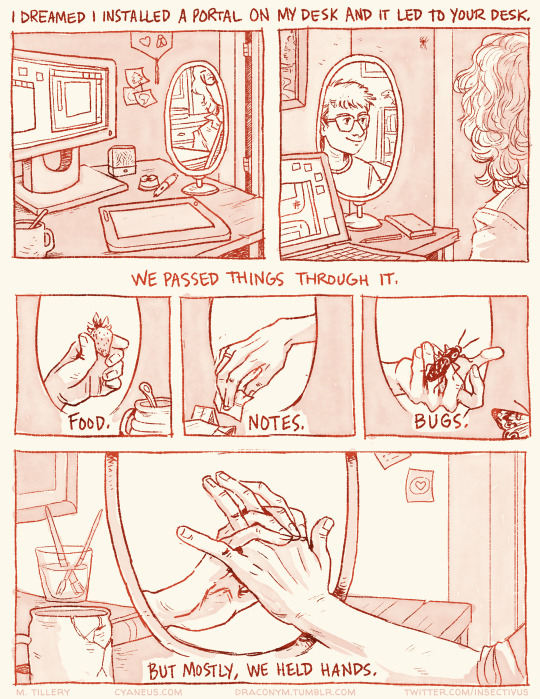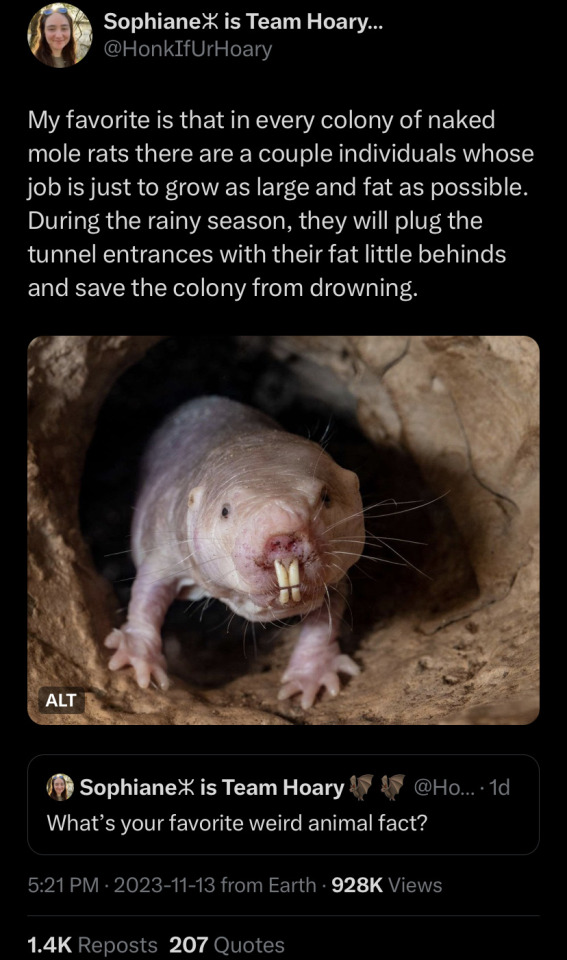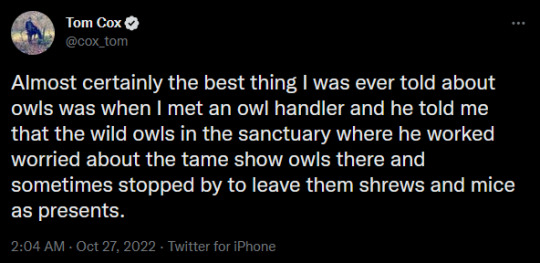Text

this from the guy who wrote the sting pain index, a scale he constructed after letting himself be stung by insects
120K notes
·
View notes
Text
A reef that has been degraded—whether by coral bleaching or disease—can’t support the same diversity of species and has a much quieter, less rich soundscape.
But new research from Woods Hole Oceanographic Institution shows that sound could potentially be a vital tool in the effort to restore coral reefs.
A healthy coral reef is noisy, full of the croaks, purrs, and grunts of various fishes and the crackling of snapping shrimp. Scientists believe that coral larvae use this symphony of sounds to help them determine where they should live and grow.
So, replaying healthy reef sounds can encourage new life in damaged or degraded reefs.
In a paper published last week in Royal Society Open Science, the Woods Hole researchers showed that broadcasting the soundscape of a healthy reef caused coral larvae to settle at significantly higher rates—up to seven times more often.
“What we’re showing is that you can actively induce coral settlement by playing sounds,” said Nadège Aoki, a doctoral candidate at WHOI and first author on the paper.
“You can go to a reef that is degraded in some way and add in the sounds of biological activity from a healthy reef, potentially helping this really important step in the coral life cycle.”
Corals are immobile as adults, so the larval stage is their only opportunity to select a good habitat. They swim or drift with the currents, seeking the right conditions to settle out of the water column and affix themselves to the seabed. Previous research has shown that chemical and light cues can influence that decision, but Aoki and her colleagues demonstrate that the soundscape also plays a major role in where corals settle.
The researchers ran the same experiment twice in the U.S. Virgin Islands in 2022. They collected larvae from Porites astreoides, a hardy species commonly known as mustard hill coral thanks to its lumpy shape and yellow color and distributed them in cups at three reefs along the southern coast of St. John. One of those reefs, Tektite, is relatively healthy. The other two, Cocoloba and Salt Pond, are more degraded with sparse coral cover and fewer fish.
At Salt Pond, Aoki and her colleagues installed an underwater speaker system and placed cups of larvae at distances of one, five, 10, and 30 meters from the speakers. They broadcast healthy reef sounds – recorded at Tektite in 2013 – for three nights. They set up similar installations at the other two reefs but didn’t play any sounds.
When they collected the cups, the researchers found that significantly more coral larvae had settled in the cups at Salt Pond than the other two reefs. On average, coral larvae settled at rates 1.7 times (and up to 7x) higher with the enriched sound environment.
The highest settlement rates were at five meters from the speakers, but even the cups placed 30 meters away had more larvae settling to the bottom than at Cocoloba and Tektite.
“The fact that settlement is consistently decreasing with distance from the speaker, when all else is kept constant, is particularly important because it shows that these changes are due to the added sound and not other factors,” said Aran Mooney, a marine biologist at WHOI and lead author on the paper.
“This gives us a new tool in the toolbox for potentially rebuilding a reef.”
Adding the audio is a process that would be relatively simple to implement, too.
“Replicating an acoustic environment is actually quite easy compared to replicating the reef chemical and microbial cues which also play a role in where corals choose to settle,” said Amy Apprill, a microbial ecologist at WHOI and a co-author on the paper.
“It appears to be one of the most scalable tools that can be applied to rebuild reefs, so we’re really excited about that potential.”"
-via Good News Network, March 17, 2024
1K notes
·
View notes
Text
772 notes
·
View notes
Text
The image captures the miraculous moment when the rays of sun hit a rare cloud called a pile cloud, and the angle and other subtle conditions are reflected in a divine rainbow color. (Source)
23K notes
·
View notes
Text
Tarantula: May I have a coke please
Waitress: All we have is Pepsis is that okay?
*Tarantula sweating nervously*: Y-you have what
25K notes
·
View notes
Text
The idea of ‘Feral Scientist’ is just so Fucking Funny to me, like ‘i just found this dude on the side of the road muttering about quantum physics is it rabid’ like thats just any scientist
96K notes
·
View notes
Text
flip the rock to see what’s under it!
🌾🌷🌾🌷🌾🪨🌾🌷🌾🌷🌾
(make sure you put it back after, don’t want to disturb the wildlife.)
24K notes
·
View notes
Text
We get pretty excited about the common siphonophore. What’s not to love?
We’re thrilled to be the first public aquarium in the world to culture and raise these delightful drifters. While these animals are incredibly fragile and difficult to see, they’re abundant and can be found throughout the ocean!
Siphonophores are colonies of tiny animals called “zooids”, and they play an important role in the oceanic food webs.
Thank you to our colleagues at @mbari-blog for the common siphonophore footage! Check out their website to learn more about these magnificent mysteries!
2K notes
·
View notes
Video
154K notes
·
View notes
Text
A type of flu virus that used to sicken people every year hasn't been spotted anywhere on Earth since March 2020. As such, experts have advised that the apparently extinct viruses be removed from next year's flu vaccines.
The now-extinct viruses were a branch of the influenza B family tree known as the Yamagata lineage. Scientists first reported the apparent disappearance of Yamagata viruses in 2021. At that time, experts speculated that precautions taken to stop the spread of COVID-19 — such as masking and social distancing — had not only driven the overall number of flu cases to historic lows but may have completely snuffed out this type of flu virus.
Continue Reading.
20K notes
·
View notes
Text
VERY IMPORTANT a dam in the Netherlands, the weerdsluis lock, is directly on a migratory path for spawning fish. They have a worker stationed there to open the door for the fish, but they can take a while to open it. So to keep the fish from getting preyed on by birds they installed a doorbell. Only, the fish don't have hands to ring the doorbell. If you go to their website, they have a LIVE CAMERA AND A DOORBELL that YOU RING FOR THE FISH when they're waiting, and then the dam worker opens the door for them! I can't express how obsessed I am with this. look at this shit. oh my god.

Please check on the fish doorbell once in a while :)
61K notes
·
View notes
Text
Researchers have discovered that leaky blood vessels, together with a hyperactive immune system may be the underlying cause of brain fog in people with long covid.
They suggest their discovery is important for the understanding of brain fog and cognitive decline – difficulty with thinking, memory or concentration – seen in some people with the condition.
It is hoped the findings will help with the development of treatments in the future.
To Summarize:
Long Covid sufferers experience symptoms like forgetfulness and concentration issues due to leakiness in brain blood vessels, according to research findings.
Scientists from Trinity College Dublin and FutureNeuro confirm that Long Covid patients with brain fog have disrupted blood vessels in their brains, making the neurological symptoms measurable.
Blood vessel leakage in the brain, along with an overactive immune system, may be the key drivers of brain fog in Long Covid patients, leading to potential changes in understanding and treating post-viral conditions.
I can't find a single right-wing news source covering this.
23K notes
·
View notes
Photo

It’s been seven months since we were in the same place
58K notes
·
View notes
Text
Saddest thing ever is reading an academic paper about a threatened or declining species where you can tell the author is really trying to come up with ways the animal could hypothetically be useful to humans in a desperate attempt to get someone to care. Nobody gives a shit about the animals that “don’t affect” us and it seriously breaks my heart
155K notes
·
View notes

